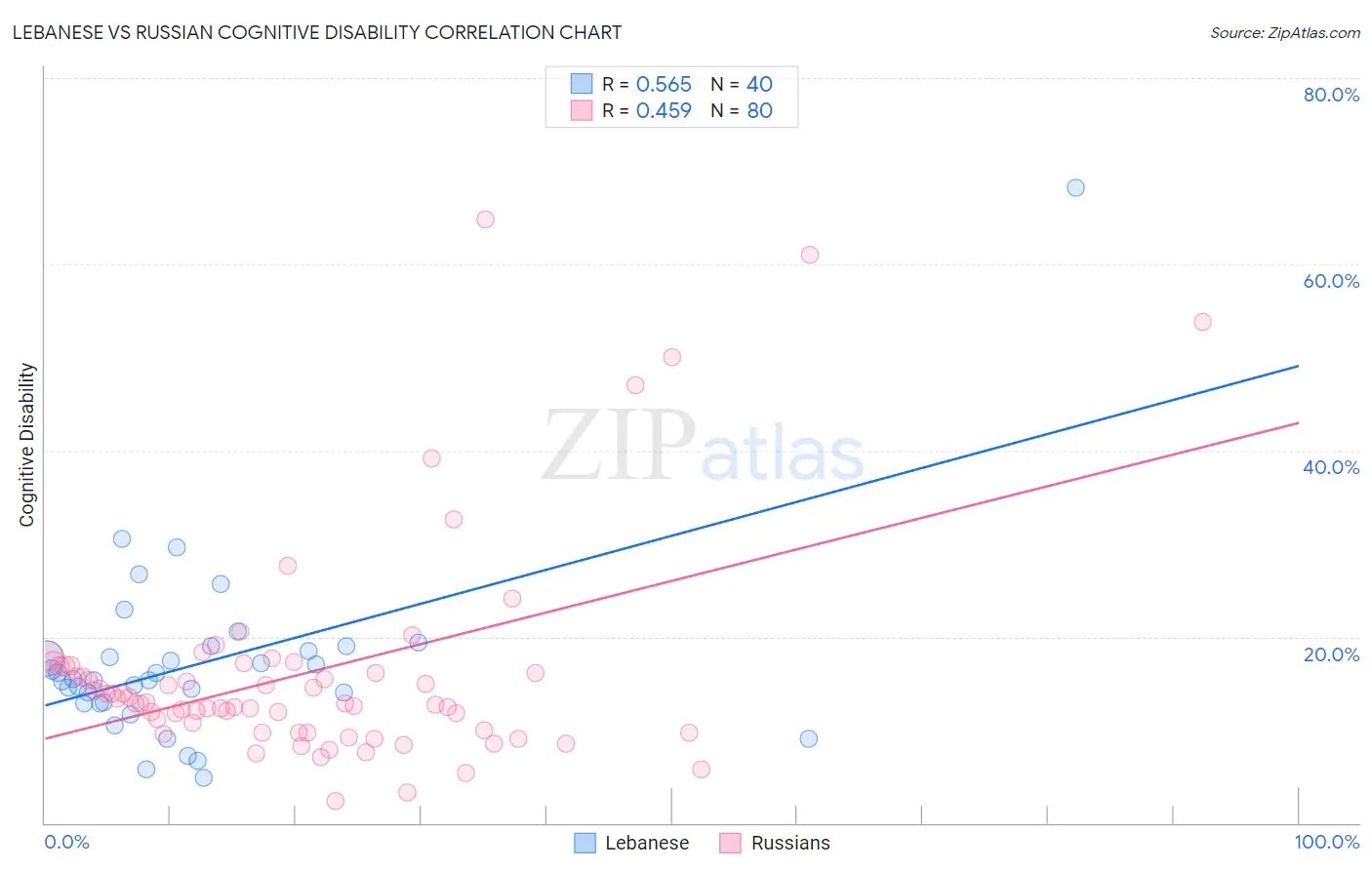Lebanese vs Russian Cognitive Disability
COMPARE
Lebanese
Russian
Cognitive Disability
Cognitive Disability Comparison
Lebanese
Russians
17.0%
COGNITIVE DISABILITY
91.3/ 100
METRIC RATING
135th/ 347
METRIC RANK
16.4%
COGNITIVE DISABILITY
99.9/ 100
METRIC RATING
34th/ 347
METRIC RANK
Lebanese vs Russian Cognitive Disability Correlation Chart
The statistical analysis conducted on geographies consisting of 401,594,018 people shows a substantial positive correlation between the proportion of Lebanese and percentage of population with cognitive disability in the United States with a correlation coefficient (R) of 0.565 and weighted average of 17.0%. Similarly, the statistical analysis conducted on geographies consisting of 512,152,080 people shows a moderate positive correlation between the proportion of Russians and percentage of population with cognitive disability in the United States with a correlation coefficient (R) of 0.459 and weighted average of 16.4%, a difference of 3.5%.

Cognitive Disability Correlation Summary
| Measurement | Lebanese | Russian |
| Minimum | 4.9% | 2.3% |
| Maximum | 68.2% | 64.9% |
| Range | 63.4% | 62.5% |
| Mean | 17.2% | 16.1% |
| Median | 15.4% | 12.9% |
| Interquartile 25% (IQ1) | 12.9% | 9.9% |
| Interquartile 75% (IQ3) | 18.7% | 16.8% |
| Interquartile Range (IQR) | 5.9% | 7.0% |
| Standard Deviation (Sample) | 10.1% | 11.7% |
| Standard Deviation (Population) | 10.0% | 11.6% |
Similar Demographics by Cognitive Disability
Demographics Similar to Lebanese by Cognitive Disability
In terms of cognitive disability, the demographic groups most similar to Lebanese are Israeli (17.0%, a difference of 0.030%), Immigrants from Norway (17.0%, a difference of 0.030%), Immigrants from Chile (17.0%, a difference of 0.040%), Welsh (17.0%, a difference of 0.050%), and Immigrants from Jordan (17.0%, a difference of 0.060%).
| Demographics | Rating | Rank | Cognitive Disability |
| Nicaraguans | 93.0 /100 | #128 | Exceptional 17.0% |
| Immigrants | Uruguay | 92.9 /100 | #129 | Exceptional 17.0% |
| Immigrants | Vietnam | 92.4 /100 | #130 | Exceptional 17.0% |
| Immigrants | Germany | 92.1 /100 | #131 | Exceptional 17.0% |
| Whites/Caucasians | 92.1 /100 | #132 | Exceptional 17.0% |
| Immigrants | Jordan | 91.9 /100 | #133 | Exceptional 17.0% |
| Immigrants | Chile | 91.7 /100 | #134 | Exceptional 17.0% |
| Lebanese | 91.3 /100 | #135 | Exceptional 17.0% |
| Israelis | 91.0 /100 | #136 | Exceptional 17.0% |
| Immigrants | Norway | 90.9 /100 | #137 | Exceptional 17.0% |
| Welsh | 90.8 /100 | #138 | Exceptional 17.0% |
| French | 90.0 /100 | #139 | Excellent 17.0% |
| Chileans | 89.9 /100 | #140 | Excellent 17.0% |
| Aleuts | 89.9 /100 | #141 | Excellent 17.0% |
| Carpatho Rusyns | 89.6 /100 | #142 | Excellent 17.0% |
Demographics Similar to Russians by Cognitive Disability
In terms of cognitive disability, the demographic groups most similar to Russians are Italian (16.4%, a difference of 0.0%), Immigrants from Israel (16.4%, a difference of 0.080%), Slovak (16.4%, a difference of 0.080%), Greek (16.4%, a difference of 0.090%), and Immigrants from Romania (16.4%, a difference of 0.13%).
| Demographics | Rating | Rank | Cognitive Disability |
| Immigrants | Pakistan | 99.9 /100 | #27 | Exceptional 16.4% |
| Poles | 99.9 /100 | #28 | Exceptional 16.4% |
| Filipinos | 99.9 /100 | #29 | Exceptional 16.4% |
| Czechs | 99.9 /100 | #30 | Exceptional 16.4% |
| Immigrants | Romania | 99.9 /100 | #31 | Exceptional 16.4% |
| Immigrants | Israel | 99.9 /100 | #32 | Exceptional 16.4% |
| Italians | 99.9 /100 | #33 | Exceptional 16.4% |
| Russians | 99.9 /100 | #34 | Exceptional 16.4% |
| Slovaks | 99.9 /100 | #35 | Exceptional 16.4% |
| Greeks | 99.9 /100 | #36 | Exceptional 16.4% |
| Slovenes | 99.9 /100 | #37 | Exceptional 16.5% |
| Immigrants | Eastern Europe | 99.9 /100 | #38 | Exceptional 16.5% |
| Bolivians | 99.9 /100 | #39 | Exceptional 16.5% |
| Immigrants | Belarus | 99.9 /100 | #40 | Exceptional 16.5% |
| Cubans | 99.9 /100 | #41 | Exceptional 16.5% |